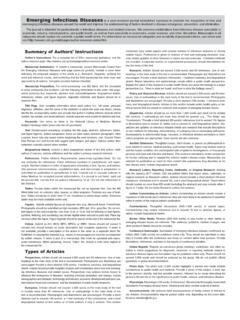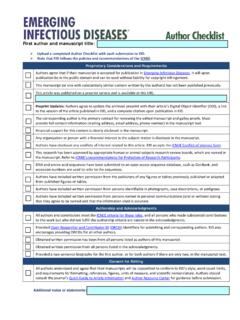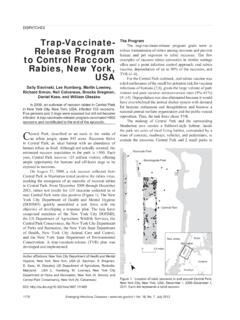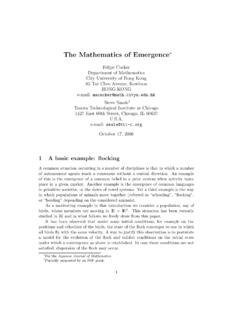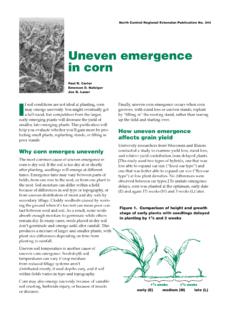Transcription of Factors in the Emergence of Infectious Diseases
1 Factors in the Emergence of Infectious DiseasesStephen S. Morse, Rockefeller University, New York, NewYork, USA Emerging Infectious Diseases can be defined as infections that have newlyappeared in a population or have existed but are rapidly increasing in incidence orgeographic range. Among recent examples are HIV/AIDS, hantavirus pulmonarysyndrome, Lyme disease , and hemolytic uremic syndrome (a foodborne infectioncaused by certain strains of Escherichia coli). Specific Factors precipitating diseaseemergence can be identified in virtually all cases.
2 These include ecological, environ-mental, or demographic Factors that place people at increased contact with a pre-viously unfamiliar microbe or its natural host or promote dissemination. Thesefactors are increasing in prevalence; this increase, together with the ongoing evolutionof viral and microbial variants and selection for drug resistance, suggests thatinfections will continue to emerge and probably increase and emphasizes the urgentneed for effective surveillance and control.
3 Dr. David Satcher s article and thisoverview inaugurate Perspectives, a regular section in this journal intended topresent and develop unifying concepts and strategies for considering emerginginfections and their underlying Factors . The editors welcome, as contributions to thePerspectives section, overviews, syntheses, and case studies that shed light on howand why infections emerge, and how they may be anticipated and Diseases emerging throughout historyhave included some of the most feared plagues of thepast.
4 New infections continue to emerge today, whilemany of the old plagues are with us still. These areglobal problems (William Foege, former CDC direc-tor now at the Carter Center, terms them globalinfectious disease threats ). As demonstrated by in-fluenza epidemics, under suitable circumstances, anew infection first appearing anywhere in the worldcould traverse entire continents within days can define as emerging infections that havenewly appeared in the population, or have existedbut are rapidly increasing in incidence or geographicrange (1,2).
5 Recent examples of emerging diseasesin various parts of the world include HIV/AIDS;classic cholera in South America and Africa; choleradue to Vibrio cholerae O139; Rift Valley fever; han-tavirus pulmonary syndrome; Lyme disease ; andhemolytic uremic syndrome, a foodborne infectioncaused by certain strains of Escherichia coli (in theUnited States, serotype O157:H7).Although these occurrences may appear inexpli-cable, rarely if ever do emerging infections appearwithout reason. Specific Factors responsible for dis-ease Emergence can be identified in virtually allcases studied (2-4).
6 Table 1 summarizes the knowncauses for a number of infections that have emergedrecently. I have suggested that Infectious diseaseemergence can be viewed operationally as a two-stepprocess: 1) Introduction of the agent into a new hostpopulation (whether the pathogen originated in theenvironment, possibly in another species, or as avariant of an existing human infection), followed by2) establishment and further dissemination withinthe new host population ( adoption ) (4). Whateverits origin, the infection emerges when it reaches anew population.
7 Factors that promote one or both ofthese steps will, therefore, tend to precipitate dis-ease Emergence . Most emerging infections, and evenantibiotic-resistant strains of common bacterialpathogens, usually originate in one geographic loca-tion and then disseminate to new places (5).Regarding the introduction step, the numerousexamples of infections originating as zoonoses (7,8)suggest that the zoonotic pool introductions ofinfections from other species is an important andpotentially rich source of emerging Diseases ; peri-odic discoveries of new zoonoses suggest that thezoonotic pool appears by no means exhausted.
8 Onceintroduced, an infection might then be disseminatedthrough other Factors , although rapid course andhigh mortality combined with low transmissibilityare often limiting. However, even if a zoonotic agentis not able to spread readily from person to personand establish itself, other Factors ( , nosocomialinfection) might transmit the infection. Additionally,if the reservoir host or vector becomes more widelydisseminated, the microbe can appear in new for correspondence: Stephen S. Morse, TheRockefeller University, 1230 York Avenue, Box 120, NewYork, NY 10021-6399, USA; fax 212-327-7172; 1, No.
9 1 January-March 19957 Emerging Infectious DiseasesTable 1. Recent examples of emerging infections and probable Factors in their emergenceInfection or AgentFactor(s) contributing to Emergence ViralArgentine, Bolivian hemorrhagicfeverChanges in agriculture favoring rodent hostBovine spongiformencephalopathy (cattle)Changes in rendering processesDengue, dengue hemorrhagic fever Transportation, travel, and migration; urbanizationEbola, MarburgUnknown (in Europe and the United States, importation of monkeys)HantavirusesEcological or environmental changes increasing contact with rodent hostsHepatitis B, CTransfusions, organ transplants, contaminated hypodermic apparatus,sexual transmission, vertical spread from infected mother to childHIVM igration to cities and travel.
10 After introduction, sexual transmission,vertical spread from infected mother to child, contaminated hypodermicapparatus (including during intravenous drug use), transfusions, organtransplantsHTLVC ontaminated hypodermic apparatus, otherInfluenza (pandemic)Possibly pig-duck agriculture, facilitating reassortment of avian andmammalian influenza viruses*Lassa feverUrbanization favoring rodent host, increasing exposure (usually in homes)Rift Valley feverDam building, agriculture, irrigation; possibly change in virulence orpathogenicity of virusYellow fever (in new areas)Conditions favoring mosquito vector BacterialBrazilian purpuric fever(Haemophilus influenzae,biotype aegyptius)Probably new strainCholeraIn recent epidemic in South America, probably introduced from Asia by ship,with spread facilitated by reduced water chlorination.
